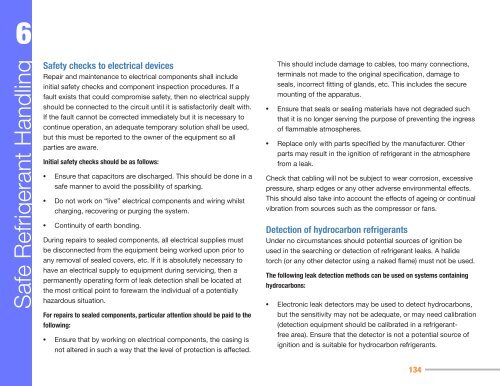Manual for Refrigeration Servicing Technicians - UNEP - Division of ...
Manual for Refrigeration Servicing Technicians - UNEP - Division of ...
Manual for Refrigeration Servicing Technicians - UNEP - Division of ...
Create successful ePaper yourself
Turn your PDF publications into a flip-book with our unique Google optimized e-Paper software.
6<br />
Safe Refrigerant Handling<br />
Safety checks to electrical devices<br />
Repair and maintenance to electrical components shall include<br />
initial safety checks and component inspection procedures. If a<br />
fault exists that could compromise safety, then no electrical supply<br />
should be connected to the circuit until it is satisfactorily dealt with.<br />
If the fault cannot be corrected immediately but it is necessary to<br />
continue operation, an adequate temporary solution shall be used,<br />
but this must be reported to the owner <strong>of</strong> the equipment so all<br />
parties are aware.<br />
Initial safety checks should be as follows:<br />
• Ensure that capacitors are discharged. This should be done in a<br />
safe manner to avoid the possibility <strong>of</strong> sparking.<br />
• Do not work on “live” electrical components and wiring whilst<br />
charging, recovering or purging the system.<br />
• Continuity <strong>of</strong> earth bonding.<br />
During repairs to sealed components, all electrical supplies must<br />
be disconnected from the equipment being worked upon prior to<br />
any removal <strong>of</strong> sealed covers, etc. If it is absolutely necessary to<br />
have an electrical supply to equipment during servicing, then a<br />
permanently operating <strong>for</strong>m <strong>of</strong> leak detection shall be located at<br />
the most critical point to <strong>for</strong>ewarn the individual <strong>of</strong> a potentially<br />
hazardous situation.<br />
For repairs to sealed components, particular attention should be paid to the<br />
following:<br />
• Ensure that by working on electrical components, the casing is<br />
not altered in such a way that the level <strong>of</strong> protection is affected.<br />
This should include damage to cables, too many connections,<br />
terminals not made to the original specification, damage to<br />
seals, incorrect fitting <strong>of</strong> glands, etc. This includes the secure<br />
mounting <strong>of</strong> the apparatus.<br />
• Ensure that seals or sealing materials have not degraded such<br />
that it is no longer serving the purpose <strong>of</strong> preventing the ingress<br />
<strong>of</strong> flammable atmospheres.<br />
• Replace only with parts specified by the manufacturer. Other<br />
parts may result in the ignition <strong>of</strong> refrigerant in the atmosphere<br />
from a leak.<br />
Check that cabling will not be subject to wear corrosion, excessive<br />
pressure, sharp edges or any other adverse environmental effects.<br />
This should also take into account the effects <strong>of</strong> ageing or continual<br />
vibration from sources such as the compressor or fans.<br />
Detection <strong>of</strong> hydrocarbon refrigerants<br />
Under no circumstances should potential sources <strong>of</strong> ignition be<br />
used in the searching or detection <strong>of</strong> refrigerant leaks. A halide<br />
torch (or any other detector using a naked flame) must not be used.<br />
The following leak detection methods can be used on systems containing<br />
hydrocarbons:<br />
• Electronic leak detectors may be used to detect hydrocarbons,<br />
but the sensitivity may not be adequate, or may need calibration<br />
(detection equipment should be calibrated in a refrigerantfree<br />
area). Ensure that the detector is not a potential source <strong>of</strong><br />
ignition and is suitable <strong>for</strong> hydrocarbon refrigerants.<br />
134

















